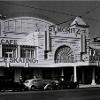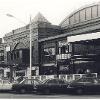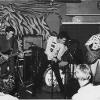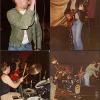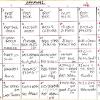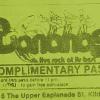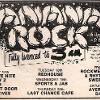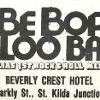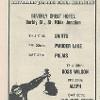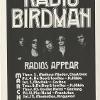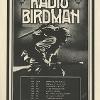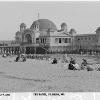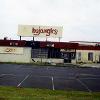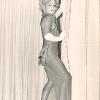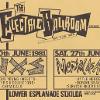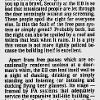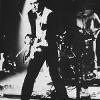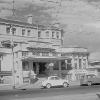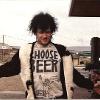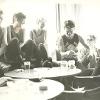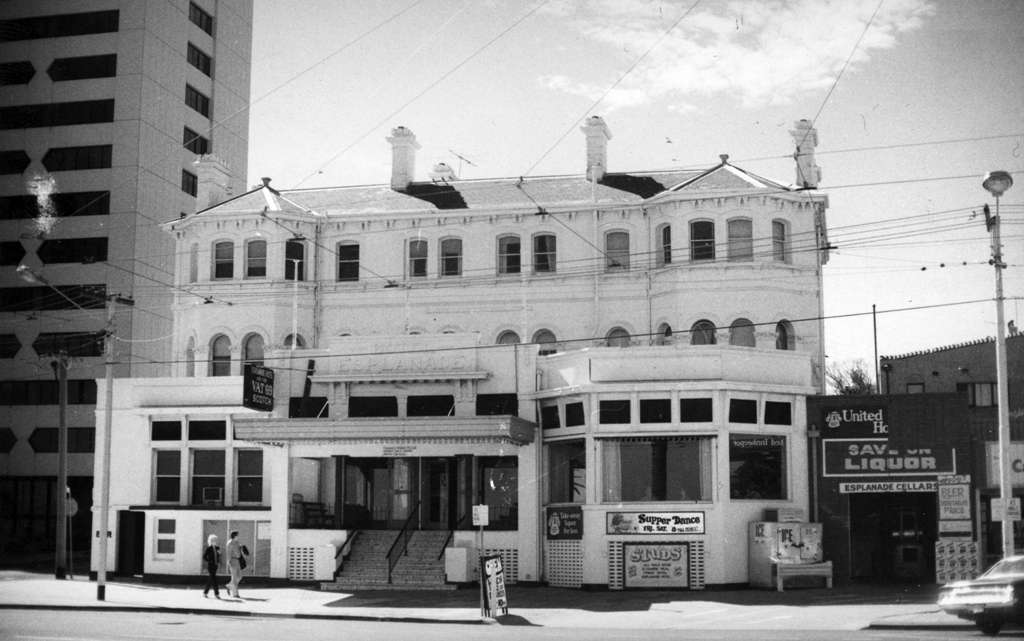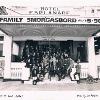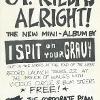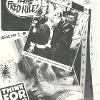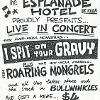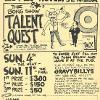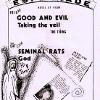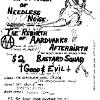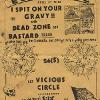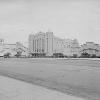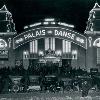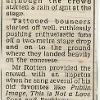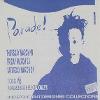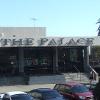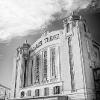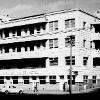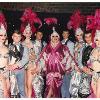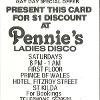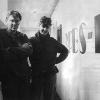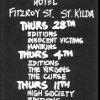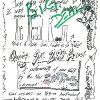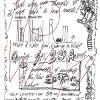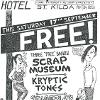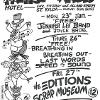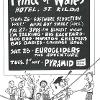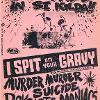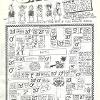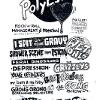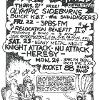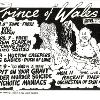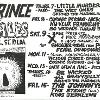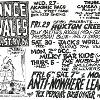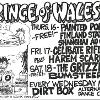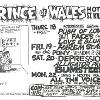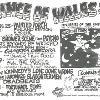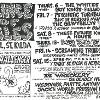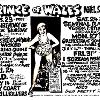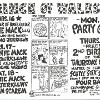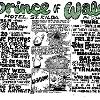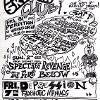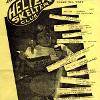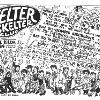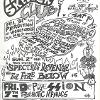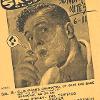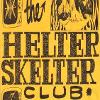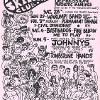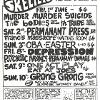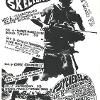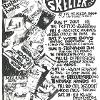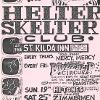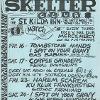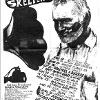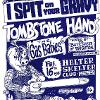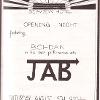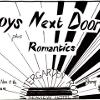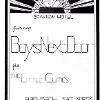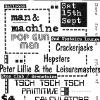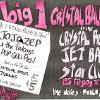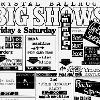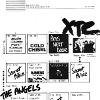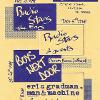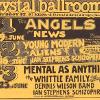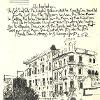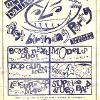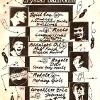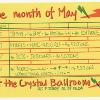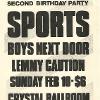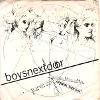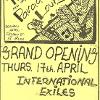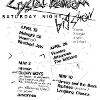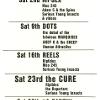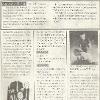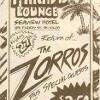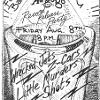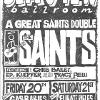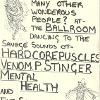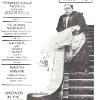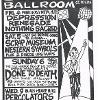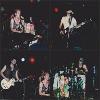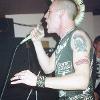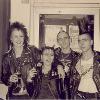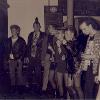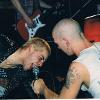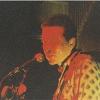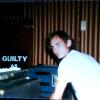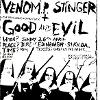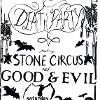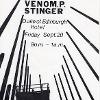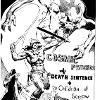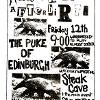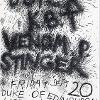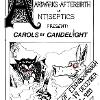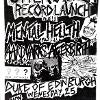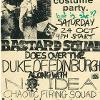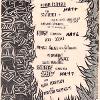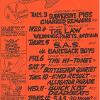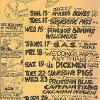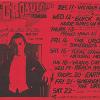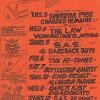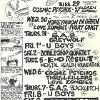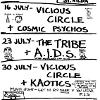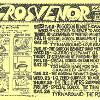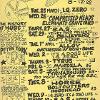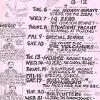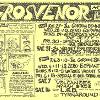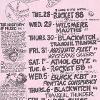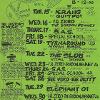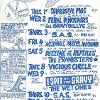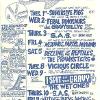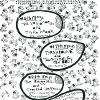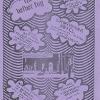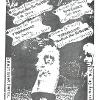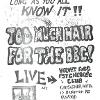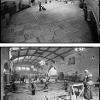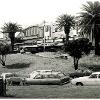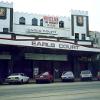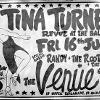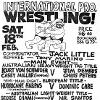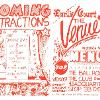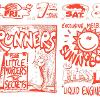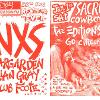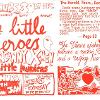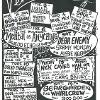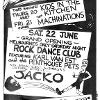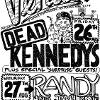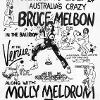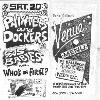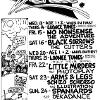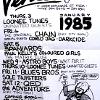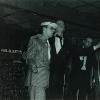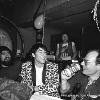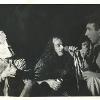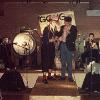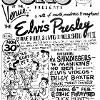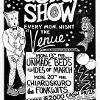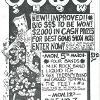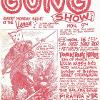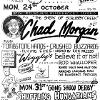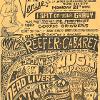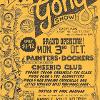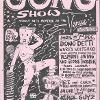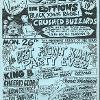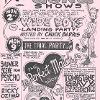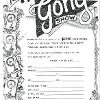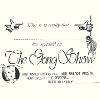During the decade between 1977 - 1987 many of Melbourne's underground music venues provided a much-needed home and safe-haven to the young people who considered themselves part of the emerging 'punk' scene. These venues, which offered an alternative to the large suburban 'beer barns', allowed both musicians and punters a place and space that allowed for sincerity, intimacy, individuality, non-conformity and the freedom of experimentation and creative expression that was often in opposition to those practices deemed formulaic or commercially driven.
Underground gigs were often promoted through word-of-mouth, by hand-drawn fliers that were disseminated around town (placed under car windscreen wipers, taped on telephone poles, or stuck up in shop windows), or by announcements on community radio stations such as 3RRR or 3PBS.
Throughout the 1960s and 1970s, and right up until 1987, a law by the Liquor Control Act meant that venues had to supply ‘supper’ with the sale of alcohol after 6pm. This law meant that all kinds of ‘food’ ranging from Strasbourg on white bread with soggy lettuce and tomato sauce, to hot chips, dim sims and BBQ shapes were served up to the hungry and unfussy punk audiences who were either too drunk or too high on drugs, such as pseudoephedrine and Mandrax, to care.
And for many of these young punks, who were either students or unemployed, this was one of the few meals that they may have eaten all week.
Underground venues existed on both sides of the river. In Carlton, Fitzroy, Clifton Hill and the CBD were venues such as Hearts, Martinis, The Champion Hotel, The Clifton Hill Community Music Centre, Bernhardts and the 475 Club. While in St Kilda there was The Seaview/Crystal Ballroom, Prince of Wales Hotel, St Kilda Inn, Duke of Edinburgh Hotel, and Grosvenor Hotel.
All of these venues gave young Melbourne punks a place to listen to the best punk bands and underground music of the day and the opportunity to *pogo or thrash it out on the dancefloor.
*The pogo is a dance in which the dancers jump up and down, while remaining in the same location.
Listed below are many, if not all, of the venues that hosted punk, post-punk and associated rock bands between 1977 - 1987. I have done my best to find detailed information on the venues that are highlighted in yellow. Please scroll down the page to find out more about these venues.
BANANAS/ BE BOP AND LOO BAR/ BERNHARDTS/ BOMBAY ROCK/ BUILDERS ARMS HOTEL/ CENTRAL CLUB HOTEL/ CHAMPION HOTEL/ COMMERCIAL HOTEL/ CLIFTON HILL COMMUNITY MUSIC CENTRE/ DUKE OF EDINBURGH HOTEL/ DUKE OF YORK HOTEL/ ELECTRIC BALLROOM/ EXFORD HOTEL/ 475 CLUB/ GROSVENOR HOTEL/ HEARTS/ HOTEL ESPLANADE/ JOHN BARLEYCORN HOTEL/ JUMP CLUB/ KILLAYONI CLUB/ LONDON TAVERN/ MACYS/ MARIJUANA HOUSE/ MARKET HOTEL/ MARTINIS/ MT ERICA HOTEL/ NAPIER HOTEL/ OLD GREEK THEATRE/ OXFORD HOTEL/ PALACE/PALAIS/ PRINCE OF WALES HOTEL/ QUEEN’S ARMS/ RICHMOND CLUB/ ST KILDA INN/ SARAH SANDS HOTEL/ STATION HOTEL/ SYDENHAM HOTEL/ TELEGRAPH HOTEL/ THE KINGSTON HOTEL/ THE QUEENS ARMS/ MUSICIAN'S UNION/ THE BALLROOM (SEAVIEWCRYSTAL)/ THE CLUB/ THE IVANHOE HOTEL/ THE TELEGRAPH HOTEL/ THE TOTE HOTEL/ THE VENUE/ TIGER LOUNGE/ USERS CLUB/
OTHER - COLLINGWOOD TOWN HALL/ COUNCIL OF ADULT EDUCATION/ FESTIVAL HALL/ HELLENIC CLUB/ LYNALL HALL/ ORMOND HALL/ MELBOURNE UNIVERSITY/ PRESTON INSTITUTE OF TECHNOLOGY/ RMIT/ RICHMOND TOWN HALL/ SWINBURNE COLLEGE/ THE ABERDEEN HALL/ THE FRINGE CLUB/ VICTORIAN COLLEGE OF THE ARTS/
Above the St Moritz ice skating rink was a little venue known as Bananas which became an iconic live venue for Melbourne's music during the 70's and 80's. Before 'The Ballroom' scene exploded, Bananas was one of the only places in St Kilda where you could see punk bands like the Boys Next Door, The Editions, The Virgins, Negatives, Models and La Femme.
Saint Moritz was a dance hall that had been turned into an ice-skating rink. You'd enter a door by the main entrance, go up the stairs, and find a room wrapped around a bar, leather padded booths and a view of the bay behind the band. Bananas was destroyed by fire on 22nd September 1982 and then stood derelict until the Novotel Hotel was built on the site and opened in 1991.

|
Bananas.pdf Size : 397.36 Kb Type : pdf |
Described as "Australia’s first Rock’n’Roll Menagerie", The Be Bop and Loo Bar was situated at the Beverly Crest Hotel, (now the Crest on Barkly). Not only did mainstream rock bands such as Skyhooks and Cold Chisel play there in the mid to late 70s, but interstate punk bands The Saints and Radio Birdman also graced the Bar in 1977.
According to Rob Wellington from the band International Exiles, early Melbourne punk was more than anything influenced by The Saints. Wellington noted one particularly seminal show in 1977 at the Be Bop and Loo Bar with himself, Chris Walsh (Negatives), and Nick Cave (Boys Next Door) in attendance.

|
The Saints.pdf Size : 617.146 Kb Type : pdf |
In 1929 the St Kilda City Engineer’s Department designed the new St Kilda Sea Baths. A spacious and solid structure, the women’s section had Islamic fretwork screens and Moorish domical towers which echo the pairs of domical towers at the Palais, at Luna Park and elsewhere in St Kilda. The men’s section had arcades facing the shore, with wavy Spanish Mission parapets and decoration. The new Sea Baths opened in 1931, but by then, the concept of enclosed sea baths was already outmoded, and the baths were never successful as envisaged. The building deteriorated due to lack of maintenance, and by 1950 the wings of the baths which stretched east to sea were considered unsafe and closed. After 1955, under a new operator, the deteriorated men’s baths and the decorative parapets were demolished, and the toilets closed.
In the 1970s a sequence of night-clubs operated in the structure including Les Girls where drag shows were regularly performed, and the infamous Bojangles - a bustling criminal hotspot, notorious for its violence and several deaths - only the very brave, hard-core, and out-there dared to venture there at night. However, the notorious reputation didn’t stop entrepreneur Laurie Richards from starting another one of his music venues. This time it was The Electric Ballroom, situated just to the right of Bojangles.
A central part of the St Kilda venue circuit that encouraged a greater mixture of music genres, audiences and local experimentation, The Electric Ballroom was started in 1981 after Richards had finished his tenure at the Crystal Ballroom (perhaps that is why he had called it the Electric Ballroom). Offering free entry before 10pm, as well as free passes to see bands on Thursday nights, The Electric Ballroom was licensed until 3am. This late license provided an opportunity for The Crystal Ballroom crowd to go to The Electric Ballroom to get a free entry stamp, go back to the Crystal ballroom until it closed, and then return to The Electric Ballroom to continue the night (if they dared to venture down there).
Local and interstate punk and post-punk bands played at the Electric Ballroom including Little Murders, INXS, Serious Young Insects, Hunters & Collectors, Dorian Gray, The Models, The Editions and The Reels amongst others.
One of the most instantly identifiable and iconic venues in St Kilda is the Esplanade Hotel or ‘Espy’. Originally built as the New Bath Hotel in 1856, it was demolished in the 1860s, and rebuilt in 1878. In 1921 alterations were made, changing it from exclusive residential use for the wealthy to incorporate entertainment for the middle classes, with the addition at the ground floor of a grand staircase and lounge bar. The Espy was set to become one of the largest and most prominent 19th century resort hotels in Victoria. Between 1920 and 1925, the Eastern Tent Ballroom constructed to the rear of the site became an important jazz and dance venue, then the main entertainment district in Melbourne. In the 1970s, the Hotel's Gershwin Room, a grand dining room, was turned into a disco - complete with a flashing Saturday Night Fever-style dance floor.
The Espy was a popular drinking spot for many St Kilda residents and local punks such as the crew from the band I Spit on Your Gravy (formed in 1983); in fact, lead singer Fred Negro became the Espy cleaner in 1984 and was also doing the Espy handbills as well.
In 1984 I Spit on Your Gravy issued a 12” EP titled ‘St Kilda's Alright’, with the cover photo being taken on the steps of the Espy. The EP included a ten-page booklet titled Suck This Fred Nile, that local police declared was “obscene” and confiscated all available copies due to Negro's “debauched” cartoons and photocopied pornographic images. As for the music itself, music historian Ian McFarlane declared it was “desperately inept and sounded like it had been recorded at the bottom of a dam.”

|
Hotel Esplanade (The Espy).pdf Size : 416.793 Kb Type : pdf |
Palais Theatre:
There have been four different Palais cinemas in St Kilda, most confusingly, three of them on the Esplanade. The open-air Pictureland opened in 1909 in Alfred Square West and was renamed the Palais from 1914-15. It closed and was demolished in 1916. The open-air Elite Biograph opened in 1912, on the corner of Barkly and Acland Street, and became the Palais from 1915-18. It was demolished in 1921. The American Phillips Brothers (Herman and Leon) secured the lease for the land on which they erected Luna Park in 1912 and the large timber Palais de Danse in 1913 (The former site of The Palace). After the war, in 1919, a steel-framed, arched truss structure was built over the old dancehall. The hall was then dismantled and re-erected next door, to the north. In 1922, Walter Burley Griffin and his wife Marion Mahoney began designing a remodelled Palais Pictures. Construction of which began in 1925, but a spectacular fire engulfed the stage in February 1926, just before completion. When the Griffin's moved on to Sydney, the developers commissioned Henry E. White to build a larger, grander theatre, which opened in November 1927 and is where the current Palais Theatre still stands today.
With the cinema's decline in popularity, the Elizabethan Trust reinvigorated Palais Pictures with ballet and opera at the renamed Palais Theatre. In the 1960s, the Palais Theatre was seldom dark. There were musicals, the Royal Ballet appeared with Margot Fonteyn, and rock'n'roll's biggest stars appeared, including The Rolling Stones, Tom Jones, The Beach Boys, Roy Orbison and Australia's own Johnny O'Keefe.
From 1977-1987 The Palais became the venue of choice for many major overseas punk and post-punk acts including Elvis Costello, Gary Numan, The Cure, Pretenders, Madness, The Human League, Duran Duran, New Order, John Cooper-Clarke, The Stranglers, Patti Smith, Blondie and PIL. Interstate and local bands such as The Saints, INXS, and The Models also played there. In 2017 the Palais was restored by the Victorian Government.
In 1987 the Fashion Design Council held ‘Fashion 87’ at The Palais.
The Palace:
Situated next door to the Palais, was an entertainment complex called The Palace that was built in 1972 on the site of the former Palais de Danse, which had burned down in 1968.
Palais de Danse was opened on 20 December 1913 as a dance venue. However, with the coming of the Great War the management thought it more appropriate to show films instead. This proved a very popular choice. To cater for the growing demand, in 1920 it was decided to replace the auditorium with a much larger building. This was constructed over the top of the original structure thus allowing performances to continue uninterrupted during the construction process. On completion of the new structure, the earlier building was disassembled except for the first bay containing the foyer. This was then re-erected on the adjoining site to once again function as a dance venue under the name of Palais de Danse.
Once it was built, The Palace became the new place to party and dance to local and international acts including Prince, the Pixies, The Cramps, Eagles of Death Metal, Queens of the Stone Age, Moby, Anthrax, The Killers, Slipknot, The Living End, Billy Thorpe, Jimmy Barnes, Rose Tattoo, the Coloured Balls, the Arctic Monkeys, Sonic Youth, Toto, Kings of Leon, Franz Ferdinand, Beasts of Bourbon, the Masters Apprentices, Paul Kelly, Dallas Crane, Steve Vai, MC5, Hoodoo Gurus, Spiderbait, Violent Femmes, and the White Stripes, before it too was suspiciously burnt down in 2007.
The Prince of Wales Hotel, AKA The Prince or POW was opened as a guesthouse in 1862, but its reputation as one of Melbourne’s grandest hotels did not come about until its rebuilding in 1936. The Prince of Wales was very popular amongst American soldiers stationed in Melbourne during the Second World War – an officer’s club was established there to cater to the many officers from Base Section Four Headquarters in Port Melbourne. The presence of the Americans attracted a large number of Australian women eager to engage with these exotic newcomers whose style and manner was far more desirable than that of the local men. It therefore gained a reputation as a venue for "meeting and mating".
In 1977 ex-policeman Ross McVean became the Manager of The Prince and not long afterwards two gay entrepreneurs, Doug Lucas and Jan Hillier, approached him about starting up a new night. McVean doubted their claim that a drag show could fill the pub's entire first floor, including the main showroom, a long dimly lit piano bar, and the Regal Room, a tiny side room off the Piano Bar. But Pokeys, ended up being held every Sunday night for 14 years with no less than 1000 people in attendance each time, while Pennies, a lesbian disco which was held every alternate Saturday night, attracted around 500 people. The Prince was truly a pivotal meeting place for Melbourne’s gay population.
PBSFM / Polyester Management and Promotion:
In 1979 independent radio station 3PBSFM placed an ad in a newspaper saying they were looking for premises to broadcast from. Brian Ballantyne, then owner of the Prince of Wales, offered them the rooms out the back of the hotel for free. PBS then set about building two studios, a lounge area and a small office at the back of the Prince. The first broadcast from the new premises was on December 21, 1979. At this point PBS was transmitting at 107.7FM, and the broadcast range was limited. 'Soul Shakedown' parties were held at the Prince of Wales to raise money to buy a new transmitter, with bands like Asylum, The Hypnotics and Mental as Anything playing. Regular PBS benefits were held at the Prince to raise much needed funds for the radio station, even after the station relocated to the Ritz Mansions, at 171 Fitzroy Street, St Kilda in 1984.
By 1982 musician and cartoonist Fred Negro was not only designing handbills and posters for the Prince, but he had also started booking bands in the Regal Room, or as he called it the ‘Illegal Room’. Not only did his band The Editions play there every Saturday night, but he also booked other local punk bands including The Virgins and Bootboys. In 1983 Negro had been busted for drawing and selling obscene handbills and had to go to court. However, he won the court case, thus setting a "freedom of expression" precedent for all Australian cartoonists.
Band promoter Paul Elliott also had an office upstairs at The Prince where he ran Polyester Management and Promotion, managing bands The Wet Ones and I Spit on Your Gravy, as well as booking gigs for bands such as Shower Scene from Psycho, Depression, The Bum Steers, Feral Dinosaurs, Young Offenders and Grong Grong. Elliott had a major hand in the success of the now infamous ‘Thursday Crawl’, booking many of the bands.
The Thursday Crawl:
In 1983 Ross McVean bought the Prince from Brian Ballantyne and went from being manager to becoming the new owner. In 1984 McVean and Graeme Richmond from The Ballroom came up with a weekly event that Fred Negro dubbed the ‘Thursday Crawl’. (He even wrote a song about it for I Spit on Your Gravy's first album 'St Kilda's Alright'.) Becoming somewhat of an institution, the Thursday Crawl consisted of 3-4 (mostly hardcore punk) bands each playing at both the Prince and The Ballroom, with free entry and cheap beer/cider. If the band at one venue wasn’t any good, then the punters left that venue for the other one and vice versa – thus there was a steady flow of punks walking up and down Fitzroy Street every Thursday night seeing free bands and drinking cheap beer. These Thursday nights were certainly the highlight of many young Punk’s lives.
End of an era:
McVean sold The Prince in 1989. He got an offer he couldn’t refuse and went on to run The Tote Hotel in Collingwood. During his 12 year tenure a myriad of local and interstate punk and post-punk bands played at the Prince of Wales Hotel including Go-Betweens, Venom P.Stinger, Sacred Cowboys, Bum Steers, Corpse Grinders, Gas Babies, Tombstone Hands, Murder Murder Suicide, Psychotic Maniacs, Depression, Permanent Damage, I Spit on Your Gravy, Civil Dissident, Shower Scene from Psycho, Good and Evil, Lubricated Goat, Exploding White Mice, The Wet Ones, The Hard Ons, Vicious Circle, Painters and Dockers, The Editions, Celibate Rifles, Died Pretty, Cosmic Psychos, Arctic Circles, Perdition, Human Waste, Seminal Rats, Arm the Insane, The Extremes, New Christs, The Zorros, Slushpuppies, The Brady Bunch Lawn Mower Massacre, X, Olympic Sideburns, Wreckery and many many more…
Pennies, Pokeys, Punks and the Prince.mp3

|
Prince of Wales Hotel.pdf Size : 609.237 Kb Type : pdf |
The St Kilda Inn was established in 1853 as the Hare and Hounds and renamed the Court House Hotel in 1861 and the Prince Charles Hotel in 1948. It was a popular sporting venue and attracted some notorious underworld figures such as ‘Pretty Dulcie’ or ‘The Angel of Death’.
The Helter Skelter Club:
In 1984, at the height of the hardcore punk movement, the then owner of the St Kilda Inn advertised for talent at his pub. Paul Elliott, who was also coordinating the ‘Gong Show’ at The Venue, put his hand up to undertake the task. The owner, who just happened to be a Beatles fan, had placed a plaque on the door to the band room that said, ‘The John Lennon Room’, so Elliott decided to come up with something that would tie in with the Beatles theme, and thus the ‘Helter Skelter Club’ was born.
With a bank of 9 B&W TVs stacked up on scaffolding, and a borrowed camera, Elliott would put on bands 7 nights a week, filming the bands as they played and playing it live back through the bank of TV’s. On other occasions there was a ‘Polyester Night’ with ‘scratch and sniff’ cards - a corresponding number would flash on the TV screen for the audience to smell – it generally started with a rose and ended up with dog turd.
Elliott already had a reputation for dealing acid (he used to have a line of people outside his Prince of Wales office during the Thursday Crawl’s), and since money was tight from the meagre door takings, he ended paying many of the bands in acid. This led to the following lyrics by Fred Negro’s band The Fuck Fucks:
“Have you never dropped acid at the Helter Skelter Club or had a blue at the St Kilda Inn?”
Sometime in 1985 the Maori publican, who hated the bands that played and the crowd that came to see them, had put his girlfriend’s head through the glass door on the night that TISM was meant to play. After that incident the owner asked Elliott to leave, which he did and took his list of bands to the Grosvenor Hotel on Brighton Road.
Over a 12-18 month period The Helter Skelter club attracted a great line-up of local and interstate punk and post-punk bands including The Triffids, Orchestra of Skin and Bone, Wet Taxis, Zimmermen, Huxton Creepers, I Spit on Your Gravy, Tombstone Hands, Gas Babies, Murder Murder Suicide, The Bodies, The Tribe, Depression, Psychotic Maniacs, Permanent Damage, Grong Grong, Shower Scene From Psycho, Corpse Grinders, Perdition, Vicious Circle, M-16, Radio Birdman, Painters and Dockers, Honeymoon in Green, The Wet Ones, Civil Dissident, Olympic Sideburns, The Mess, and many more…

|
The Helter Skelter Club.pdf Size : 569.439 Kb Type : pdf |
Built in 1857 and originally called the Terminus Hotel, this once graceful and superior hotel would eventually become one of the most infamous punk venues in Melbourne. Renamed The George Hotel in 1868, the hotel housed temporary and permanent tenants who were eager to soak up the cheery and bright St Kilda beachside atmosphere. However, with the financial ruin that the Great Depression brought in 1930 and the influx of American soldiers that WW2 brought in 1942, the face of St Kilda began to change. Drinking, dancing and sex became the norm as the park across the road from the George became one of the favourite sites in Melbourne for prostitution. A once fashionable and elegant suburb had now become a tawdry and downright criminal one.
In 1958 The George received a facelift, and a cocktail bar called ‘The Birdcage’ was built in the hotel foyer. The hotel also had its now famous crystal chandelier installed, while its beautiful mosaic tiled floor disappeared under grey carpet. The dining room was now called the ‘Crystal Room’ while the sprung wooden dancefloor became host to dances like the Twist and the Cha-cha-cha. By 1968 St Kilda’s reputation continued to deteriorate to the point where it was considered a risk to travel there. In 1976 another attempt to create a new image, along with a name change, was thrust onto The George Hotel. This time it was to become the Seaview Hotel and its new owners were former president of the Richmond Football club Graeme Richmond and ex-policeman Kevin (‘Tod’) Shelton.
Enter Punk: 'The Ballroom' (as it was commonly referred to) was Melbourne’s equivalent of New York’s CBGBs. It was run by a succession of Melbourne alternative music promoters from 1978 to 1987, starting with Dolores San Miguel, and later by Laurie Richards, founder of the Tiger Lounge in Richmond and the Jump Club in Fitzroy. Dolores took charge of booking bands at The Ballroom in August 1978, dubbing a small side room that was located upstairs as the ‘Wintergarden Room' (it had previously been called the ‘Blue Room’).
The opening night consisted of JAB, who had relocated from Adelaide, while the next official gig, 1 month later, saw The Boys Next Door headlining to a sell-out audience. The monthly success of these gigs meant that Dolores was eventually given the keys to the main ballroom and on New Year’s Eve 1978, 1000 people turned up to the venue, catching both herself and Graeme Richmond unawares. Stuffing money into their pockets and underwear, the two had to send out for pizza to satisfy the Liquor Control Act’s law of supplying ‘supper’ with the sale of alcohol after 6pm. This law meant that all kinds of ‘food’ ranging from Strasbourg on white bread with soggy lettuce and tomatoe sauce, to hot chips, dim sims and BBQ shapes were served up to the hungry and unfussy audience who were either too drunk or too high on drugs, such as pseudoephedrine and Mandrax, to care.
Monthly gigs soon became weekly events, but the success that Dolores had created soon caught the attention of another entrepreneur, Laurie Richards, who was able to attract popular interstate and international acts. He took over the venue in February 1979 and renamed it the ‘Crystal Ballroom’ because of the venue's ornate ballroom and chandeliers. The venue had two levels where bands played. People walked in from the street through the glass doors and could either walk up big marble staircase and go to the main ballroom or mingle under the chandeliers in the foyer. Here they could either have a drink at the ‘Birdcage Bar’ or watch the action from the main room on close-circuit TVs in the back bar. The ‘Snakepit’, which was the public bar downstairs, was a place that no one from the Ballroom crowd went into. It was a blood bath where mainly Aboriginals, Maoris, prostitutes and drug dealers drank.
Art students mixed with punk bands who mixed with electro bands, and everyone got on with everyone else. It was a real community with everyone being there for the love of music and fashion. Although the crowd of young people could be tough and edgy, there was rarely any heavy violence and no police arrests. If there were any fights it would get taken care of very quickly either by the Maori bouncer or Graeme Richmond himself who would take the troublemaker into the lane outside, and headbutt them. Also, during this time, a number of one-off ‘Crystal Ballroom Records’ were manufactured by Keith and Helena Glass's Missing Link and given away at certain gigs.
The Crystal Ballroom operated under that name until 10 January 1981, even though Dolores returned in April 1980 to run weeknight gigs in what she christened the ‘Paradise Lounge’ on the ground floor. The second wave of ‘Little Bands’ also played regular gigs during this period. Nigel Rennard (who was at the time working for Nucleus Creative Entertainment) co-ran the Crystal Ballroom with Dolores until a falling out in September 1981, whereby Dolores vacated her position. Rennard renamed the venue the ‘Seaview Ballroom’ and ran it until the end of 1983. Dolores returned to the venue in 1984 and ran it until 1986 before the hotel was closed for business in 1987, due to its many transgressions in liquor licensing as well as a general state of decrepitness.
Over its tenure The Ballroom was home to a host of local, interstate and international punk, post-punk and hardcore punk bands including: The Boys Next Door, The Editions, Models, Mi-Sex, Popgun Men, Primitive Calculators, La Femme, JAB, Tch Tch Tch, Essendon Airport, Wrecked Jets, Serious Young Insects, The Ears, Piano Piano, International Exiles, Equal Local, Jetsonnes, Marching Girls, News, Little Murders, The Birthday Party, Plays with Marionettes, Corporate Body, Depression, Vicious Circle, Psychotic Maniacs, I Spit on your Gravy, Permanent Damage, End Result, Death Sentence, Spring Plains, Olympic Sideburns, Mental Hellth, Venom P. Stinger, Tombstone Hands, Gas Babies, Hunters and Collectors, The Scientists, The Go-Betweens, The Church, The Saints, The Reels, The Triffids, Laughing Clowns, Simple Minds, The Cure, Magazine, The Members, XTC, The Residents, Snakefinger, and many more.

|
The Ballroom (Crystal - Seaview).pdf Size : 816.117 Kb Type : pdf |
The Duke of Edinburgh Hotel was opened in 1867. The hotel operated as the Duke of Edinburgh until 1996, then closed for a year until it reopened as a bar, ‘The Duke’, in 1998.
Also known as ‘The Puke of Edinburgh’ to many of the punters, from late 1986 - 1987 Shane Cuskelly ran Sunday punk/rock gigs called ‘The Grunge Ranch’ while around the same time Shelley Thompson was booking many of Melbourne’s hardcore punk bands for Friday and Saturday night gigs.
Many punk/post-punk and alternative rock bands played at The Duke of Edinburgh including The Zorros, Bastard Squad (who played their first ever gig at the Duke in October 1987), Arm the Insane, Aardvarks Afterbirth, Utter Stench, Mental Health, Good and Evil, Venom P. Stinger, M.I.A, Death Sentence, Depression, Chaotic Firing Squad, Stone Circus, Thug, Akashic Rags, PFM, Ku Klux Frankenstein, The Snails, Tombstone Hands, Lunatic Fringe, Boltcutters, White Elephants, Life Without Meaning, Cosmic Psychos, Exploding White Mice and many more.
Click on the PDF below to read memories about The Duke of Edinburgh by people who were there...

|
The Duke of Edinburgh Hotel.pdf Size : 557.249 Kb Type : pdf |
Built in 1860, the unimposing Grosvenor Hotel was once part of a group of coaching inns on Brighton Road, which is deeply entrenched in the early settlement of Victoria, given there were coach stops along the first track to the Mornington Peninsula.
After being asked to leave The St Kilda Inn in 1985, Paul Elliott moved his band nights to The Grosvenor Hotel. Although just over the St Kilda border in Elwood, the gigs didn’t attract the same numbers as ‘The Helter Skelter Club’ did. Elliott also hosted a psychedelic night on Saturdays that he called ‘Velvet Fogg’ as well as the ‘Loco Beach Club’ on Wednesday nights organised by Rick Ferrara with $2 entry. There was also a night called ‘The Cadillac Club Presents’.
Despite The Grosvenor Hotel, or ‘Groveller’ as it was also called, not being right in the hub of St Kilda, many of Melbourne’s hardcore punk bands played gigs there including Venom P. Stinger, White Elephants, G.A.S.H, Depression, Extremes, Foot and Mouth, Vicious Circle, No Remorse, Renegade, End Result, The Wet Ones, Weddings Parties Anything, Alligator Parade, Charred Remains, Seminal Rats, A.I.D.S, Cosmic Psychos, Kaotics, Chaos, Permanent Damage, I Spit On Your Gravy, The SLUB, The Tribe, Fungus Brains, Willsmere, Tombstone Hands, Renegade, Boltcutters, Orchestra of Skin and Bone, and many more…
Click on the PDF below to read memories about The Duke of Edinburgh by people who were there...

|
The Grosvenor Hotel.pdf Size : 406.783 Kb Type : pdf |
Right next door to Bananas was The Venue. Formerly named Earl's Court Ballroom, it was once a classic parquetry-floored dance hall that had its named changed from The Lyric to Earl's Court in 1932. It would sometimes host films and nightclubs as the Palm Grove, Sergios and the The Taxi Club. In the early 1980s, under the management of Joe Gaultieri, it was converted into a huge two-stage music venue where major bands like Dead Kennedys, The Angels, The Saints, INXS, Hunters & Collectors, Uncanny Xmen, Split Enz, Kids in the Kitchen, Tina Turner, Mental as Anything, The Cult, Style Council, The Human League and Models performed to crowds of over 2,000. Local punk and post-punk bands including Beargarden, Dorian Gray, Sacred Cowboys, The Editions and Little Murders also played there.
St Kilda artist, musician and cultural icon Fred Negro began doing the handbill graphics for The Venue at the request of Joe Gaultieri in 1983.
The Gong Show:
Paul Elliott’s ‘Gong Show’ became a Monday fixture at The Venue in October 1983 after moving from Macy’s in South Yarra. Borrowing the idea from a TV show of the same name, The Gong Show was basically an avant-garde arthouse night that consisted of a couple of bands and bizarre or stupid acts that would get ‘gonged’ by a judge if deemed unfit for viewing. Each week was different as Paul came up with a variety of ideas as to how to entertain and keep the audience.
Finding acts wasn’t hard either. Paul just put ads in the paper calling for people to come and perform. They didn’t get paid, but they could get up and do whatever they wanted. Having no budget and giving what little money he made to the bands, Paul soon discovered that putting the events on once a week was a bit too much and on 9th April 1984 the last gong was sounded. Some of the Gong Show highlights included Fred Negro, The Butcher of Brighton, Anthony Morgan, Tiny Tim and Big Rod Walloper. I Spit on your Gravy, Painters and Dockers, Spring Plains (Pre-Cosmic Psychos), Tombstone Hands and TISM also played some early gigs as part of this show.

|
The Venue.pdf Size : 542.562 Kb Type : pdf |
- Main Image - La Femme at the Tiger Lounge, 1978 - Source: Chane Chane
- Background Image - Wintergarden Room, Seaview Hotel promotional material, 1978 - Source: Dolores San Miguel
- Bananas, 1977 - 1979 - Sources: Paul Thompson and the City of Port Phillip Collection, Joe Murray, Michael Chrystal, Adrian Barker
- Be Bop and Loo Bar, 1978 - Source: Required
- Electric Ballroom - Sources: State Library of Victoria, Port Phillip City Collection, Australian Queer Archives, Rob Griffiths
- Hotel Esplanade - Sources: Fred Negro, Joe Holzer, Colin Holst, State Library of Victoria, Port Phillip City Collection
- Palais Theatre / The Palace - Sources: St Kilda Historical Society, RMIT Design Archives, Wikipedia, Eli Ajzenman
- Prince of Wales Hotel - Sources: State Library of Victoria, Australian Queer Archives, PBSFM, Fred Negro, Paul Elliott
- St Kilda Inn fliers - Source: Fred Negro
- The Ballroom - Photos - Sources: Dolors San Miguel, Kellye Richards, Port Phillip City Collection, Jeff Busby, Paul Lindsay, Fliers - Sources: Mylene Mars, Fred Negro, Timothy Hughes, Dolores San Miguel, Andy Turner, Kellye Richards, Nic Chancellor, Marina Perkovich, From the Archives, Discogs
- The Duke of Edinburgh Hotel - Sources: Jason Bastard, Steve Cotton, Col Holst, Glenn Walker, Paul Linsday, Scotti Henthorn, Marina Perkovich, Shane Cuskelly
- The Grosvenor Hotel fliers - Sources: Fred Negro, Paul Elliott, Paul Lindsay
- The Venue - Sources: Port Phillip City Collection, Paul Elliott, Fred Negro, Chris Pinsent,
- Bananas - Joe Gaultieri, Fred Negro - Source: St Kilda Music Walking Tours
- Be Bop and Loo Bar - Nick Cave on The Saints - Source: Jenkins, Jeff (2007). 50 Years of Rock in Australia. Melbourne: Wilkinson Publishing
- Crystal Ballroom -
- Hotel Esplanade - Fred Negro - Source: St Kilda Music Walking Tours
- Prince of Wales Hotel - Fred Negro - Source: St Kilda Music Walking Tours, Ross McVean - Source: Punk Journey
- St Kilda Inn - Paul Elliott - Source: Punk Journey
- The Ballroom - Gillian Upton, Dolores San Miguel, Lisa Dethridge, Rob Wellington, Cherry Ripe, Ashley Crawford, Chris McAuliffe, Roland and Crusader, Sam Sejavka, Ash Wednesday, Bruce Milne, Chane Chane, Paul Lindsay, Kev Lobotomi, Fred Negro, Warwick Brown, Vikki Riley, Tina Phillips - Sources: Upton, Gillian (2001). The George: St Kilda Life and Times, p.108: Venus Bay Books, RRRFM article, San Miguel, Dolores (2011). The Ballroom, Melbourne Books, Rowland S. Howard website, McAuliffe, Chris (1997) Let's Talk About Art: Art and Punk in Melbourne. Art and Australia, Vol 34 No 4, pp. 502-512, St Kilda Music Walking Tour, Punk Journey Riley, Vikki (1992). An extract from Death Rockers of the World Unite! Melbourne 1978-80 – Punk or no Punk rock! An essay from Pop to Punk to Postmodernism: Popular music and Australian culture from the 1960s to the 1990s (Edited by Philip Hayward): Allen & Unwin, A Love Affair (Rekindled) by Tina Phillips – an extract from St Kilda Village Strip Fest (2013)
- The Duke of Edinburgh - Shane Cuskelly - Source: Facebook / Punk Journey
- The Grosvenor Hotel - Peter C. Kohn, Laurence Aboukhater, Rick Ferrara - Source: Facebook / Punk Journey
- The Venue - Joe Gaultieri, Fred Negro - Source: St Kilda Music Walking Tours
- 'Thursday Crawl' by I Spit on your Gravy, 1984 - Source: Fred Negro
- Civil Dissident, live at the Helter Skelter Club, 1984 - Source: YouTube
- 'Beer Sandwich' by The Fuck Fucks, 1997 - Source: YouTube
- Punkline - A short Avant film about the Crystal Ballroom, St Kilda, 1980. Produced and directed by Sue Davis and Tony Stevens - Source: YouTube
- Music Around Us - New Wave, 1/4, 1980 - A video made by the ABC about New Wave music in Australia - features the Crystal Ballroom in St Kilda - Source: YouTube
- Pennies, Pokeys, Punks and the Prince - Source: ABC Hindsight
- St Kilda Music Walking Tours
- Australian Music Database
- Looking Back on The DEAD KENNEDYS' 1983 Australian Tour
- The history of live music in St Kilda part one: The past, present and future of St Kilda’s live music scene
- Index of SKHShotels
- St Kilda Sea Baths History
- St Kilda Historical Society
- Port Phillip History
- Palais Theatre History
- Victorian Places
- Victorian Collections
- Australian Queer Archives (AQuA)
- Pennies, Pokeys, Punks and the Prince - ABC listen
- The punk and alternative music scenes of St Kilda (and Melbourne) in the 1970s and 1980s
- From The Archives - Boys Next Door Chronology
- RMIT Design Archives
- Outta The Black & Into the Ether
- The Palace
- The Organ Factory - Collingwood Historical Society Inc
- Tina Turner Online - Tour 1981-1984
- Underground music - Wikipedia
- Liquor Control Act 1987
- From The Archives -The Boys Next Door- Concert Chronology
- The Boys Next Door Concerts
- Boysnextdoor / Models – Scatterbrain / Early Morning Brain (1979, Vinyl)
- I got drunk at The Crystal Ballroom | Facebook
